|
| Integral
calculus |
|
|
|
|
The
definite and indefinite integrals |
 The area between the graph
of a function and the x-axis over a closed interval
The area between the graph
of a function and the x-axis over a closed interval |
|
Geometric interpretation of the definite integral |
 The
fundamental theorem of calculus
The
fundamental theorem of calculus |
|
The
fundamental theorem of differential calculus |
 Evaluating
definite integrals using indefinite integrals
Evaluating
definite integrals using indefinite integrals |
|
The fundamental
theorem of integral calculus |
|
Evaluating the definite integral examples |
|
|
|
|
|
|
| The area between the graph
of a function and the x-axis over a closed interval |
| Geometric
interpretation of the definite integral |
| Until
now we assume that the integrand, the function that is integrated, to be
nonnegative or f (x)
>
0
for all x
in an interval [a,
b]. |
| Now suppose f
(x)
<
0
in
the whole interval or in some of its parts then, the areas of regions
between the graph
of f
and the x-axis,
which lie below or above the x-axis,
differ in the sign of f
(x). |
|
|
| Therefore,
the definite integral yields the algebraic sum of these areas taking
regions below the x-axis
negative,
as show the figures above. |
| So,
if the graph of f looks
as in the left figure above then |
 |
| hence
the definite integral represents the algebraic sum of the areas above
and below the x-axis. |
| Thus,
as the right figure above shows, follows that |
 |
|
as the area A2,
lying under the arc of the sinusoid in the interval [p,
2p]
is congruent to the area A1
in [0,
p]
but with opposite sign. |
|
|
The fundamental theorem of calculus |
| The
theorem that states the relationship between integration and
differentiation, that is, between areas and tangent
lines, is called the fundamental theorem
of calculus |
|
|
The fundamental theorem of differential calculus |
| If
f (x) is continuous on
closed interval [a,
b] and F(x)
is defined to be |
 |
| then,
F
is differentiable on (a,
b)
such that F' (x)
= f (x) for all x
in (a,
b).
This means that |
 |
|
| Evaluating definite integrals
using indefinite integrals |
| To
evaluate the definite integral |
 |
we should find one
primitive function F
(x)
or antiderivative of |
|
|
the function f (x),
and since the indefinite integral |
 |
is a primitive
function of f
(x)
then, as two |
|
| primitives
of the same function can differ only by a constant, we can write |
 |
| To
find the value of the constant C
that belongs to the lower limit a,
substitute x = a
to both sides of the |
| above equality, and
since |
 |
then C
= -
F(a),
so that |
|
 |
| Therefore,
the
definite and indefinite integrals are related by the fundamental theorem
of calculus. |
| This
result shows that integration is inverse of differentiation. |
|
| The fundamental theorem of integral calculus |
| If
f (x)
is integrable on the interval [a,
b]
and F (x)
is an antiderivative of f
on (a,
b),
then |
 |
| The
right side of the above equation we usually write |
 |
| so
that, |
 |
|
|
| Thus,
to evaluate the definite integral we need to find an atiderivative F
of f,
then evaluate F (x)
at x = b
and at x
= a, and calculate the
difference F (b)
-
F (a). |
|
| Evaluating
the definite integral examples |
| Example:
Find
the area under the line f
(x)
= x
+ 1
over the interval [1,
5]. |
| Solution:
To evaluate the
definite integral we need to find the atiderivative
F
of f (x)
= x
+ 1, evaluate F
(x) |
| at x
= 5
and at x
= 1,
and calculate the difference |
| F(5)
-
F(1). |
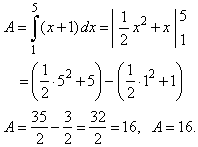 |
|
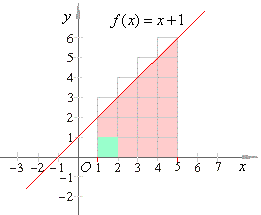 |
|
|
| Cavalieri
- Gregory formula for quadrature of the parabola |
| Example:
Let define the
surface area enclosed by the arc of the parabola f
(x)
= Ax2
+ Bx
+ C
and x-axis
over the interval [a,
b]. |
| Solution: |
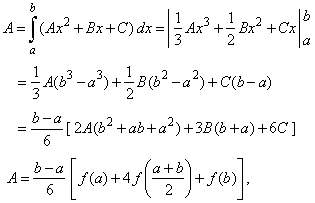 |
| where
the expression in the square brackets |
|
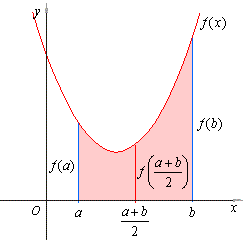 |
|
 |
| Thus,
the quadrature of the quadratic function leads to calculation of the
three ordinates or values of the function,
f (a),
f ((a+ b)/2)
and f
(b). |
|
| Example:
Find
the area enclosed by the sine function f
(x)
= sin x
and the x-axis
over the interval |
| [p/2,
3p/2].
Solution: |
|
|
 |
|
| Example:
Evaluate |
 |
|
|
| Solution: |
 |
|
|
|
| Example:
Find
the area enclosed by the graph of the cubic
f (x) = (-1/3)x3
+ 4x
and the positive part of the x-axis. |
| Solution: The
limits of integrations are defined by the roots of the cubic that we can
find by solving the |
| equation
f(x)
= 0, |
 |
|
|
 |
| The
limits of integration, x1
= 0 and x3
= 2Ö3,
so |
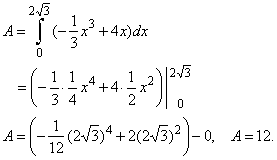 |
|
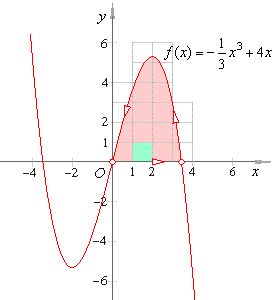 |
|
|
| Example:
Evaluate |
 |
|
|
| Solution: |
 |
|
|
|
|
|
|
|